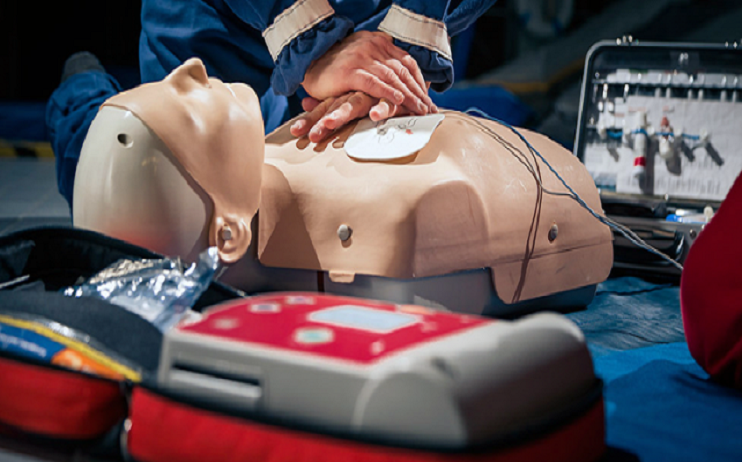Creating effective CPR/AED & First Aid training content is essential to equip participants with the knowledge and skills needed to respond confidently and effectively in emergency situations. Here’s a comprehensive outline of the key topics you can include in your training content:

CPR/AED & First aid Training
Introduction to CPR/AED and First Aid:
• Importance of CPR, AED, and First Aid training
• Good Samaritan laws and legal protections
• Chain of survival concept
• Good Samaritan laws and legal protections
• Chain of survival concept
Basic Anatomy and Physiology:
• Overview of the cardiovascular system
• Understanding the respiratory system
• Understanding the respiratory system
Cardiopulmonary Resuscitation (CPR):
• Importance of early recognition and activation
• Assessing responsiveness and calling for help
• Chest compression technique (hands-only CPR)
• Rescue breaths and mouth-to-mouth ventilation
• Compression-to-ventilation ratio
• CPR for infants, children, and adults
• Assessing responsiveness and calling for help
• Chest compression technique (hands-only CPR)
• Rescue breaths and mouth-to-mouth ventilation
• Compression-to-ventilation ratio
• CPR for infants, children, and adults
Automated External Defibrillator (AED) Usage:
• Understanding the AED and its components
• When to use an AED
• AED operation and pad placement
• AED prompts and voice instructions
• When to use an AED
• AED operation and pad placement
• AED prompts and voice instructions
Choking and Airway Obstruction:
• Recognizing signs of choking
• Abdominal thrusts (Heimlich maneuver) for conscious individuals
• Back blows and chest thrusts for infants and conscious pregnant women
• Abdominal thrusts (Heimlich maneuver) for conscious individuals
• Back blows and chest thrusts for infants and conscious pregnant women
First Aid Basics:
• Assessing the scene and ensuring safety
• Checking for responsiveness and calling for help
• Controlling bleeding and using pressure bandages
• Treating burns, cuts, and scrapes
• Recognizing and managing shock
• Checking for responsiveness and calling for help
• Controlling bleeding and using pressure bandages
• Treating burns, cuts, and scrapes
• Recognizing and managing shock
Injuries and Medical Emergencies:
• Fractures, sprains, and strains
• Head injuries and concussions
• Allergic reactions and anaphylaxis
• Diabetic emergencies
• Seizures and convulsions
• Heat-related illnesses and heatstroke
• Cold-related injuries and hypothermia
• Head injuries and concussions
• Allergic reactions and anaphylaxis
• Diabetic emergencies
• Seizures and convulsions
• Heat-related illnesses and heatstroke
• Cold-related injuries and hypothermia
Environmental Emergencies:
• Snake bites and insect stings
• Poisoning and exposure to hazardous substances
• Drowning and water-related incidents
• Poisoning and exposure to hazardous substances
• Drowning and water-related incidents
Secondary Assessment and Reporting:
• Secondary assessment of the victim
• Gathering information for medical professionals
• Effective communication during emergencies
• Gathering information for medical professionals
• Effective communication during emergencies
Hands-on Practice and Scenarios:
• Interactive practice sessions for CPR, AED, and first aid techniques
• Simulated emergency scenarios to apply skills learned
• Simulated emergency scenarios to apply skills learned
Certification and Renewal:
• Information about certification requirements and renewal periods
• Encouraging regular training updates
• Encouraging regular training updates
Mental Health First Aid Awareness (Optional):
• Recognizing signs of mental distress and crisis
• Approaches to provide initial support and assistance
• Encouraging seeking professional help
• Approaches to provide initial support and assistance
• Encouraging seeking professional help
Resources and Additional Information:
• Emergency contact numbers and local resources
• Reference materials, websites, and apps for ongoing learning
• Ensure that your training content is engaging, interactive, and tailored to your target audience's needs. Utilize visual aids, demonstrations, videos, and case studies to enhance understanding and retention. Additionally, consider providing opportunities for participants to practice skills in realistic scenarios, as this will boost their confidence and competence in real-life emergencies.
• Reference materials, websites, and apps for ongoing learning
• Ensure that your training content is engaging, interactive, and tailored to your target audience's needs. Utilize visual aids, demonstrations, videos, and case studies to enhance understanding and retention. Additionally, consider providing opportunities for participants to practice skills in realistic scenarios, as this will boost their confidence and competence in real-life emergencies.

